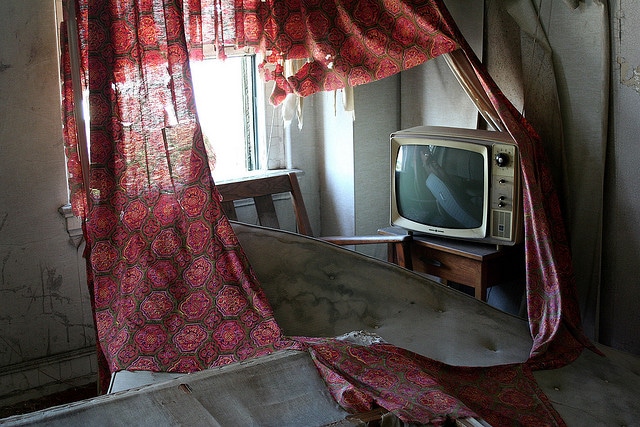Some of downtown Birmingham’s iconic vacant buildings are about to see new life as retail and residential space. This summer, construction begins on a $59-million-dollar renovation of the Pizitz building. Developers are also planning to revamp the Thomas Jefferson Hotel on Second Avenue North.
It’s no small undertaking. The 19-story building has been abandoned for three decades. What’s it like inside an old luxury hotel that’s been empty for more than 30 years? WBHM freelancer Ashley Cleek takes a glimpse inside:
In the 30 years that the hotel has been empty, it has become a sort of playground for photographers and urban explorers in Birmingham, including Bradley Boyd.
By day, Bradley Boyd is a lawyer — shined shoes, three-piece suits. But at night and on weekends, Boyd’s hobby is to break into abandoned buildings all over Alabama.
“I take pictures of abandoned buildings, urban decay, anything that’s left alone,” Boyd explains. “I want to get in it and I want to document it.”
Birmingham, Boyd says, is like a playground of vacant buildings to explore. And his favorite, by far, is the Thomas Jefferson Hotel.
Boyd has sneaked into the old hotel many times on his own. But today, we’re going in with realtor Chip Watts, the building’s former manager.
“One of the first things that you sense when you get into an abandonment is this smell,” Boyd says. Stepping inside, the smell of dust and mold pours from the open door, which Boyd says he genuinely likes.
And the history of the Thomas Jefferson Hotel charts Birmingham’s rise and fall.
The hotel opened in 1929, less then two months before the historic crash on Wall Street. It was an expensive project. The hotel had luxuries like air conditioning and elevators. A massive ballroom on the second floor once had thick marble columns and terra cotta ceilings. High schools would hold senior proms here.
Now much of the marble has been stripped away. In the middle of the floor there’s a kiddie pool filled with crusty T-shirts and beer bottles. There’s still an out-of-tune piano left in the lobby.
The 1970s marked a decade of decline for the hotel as newer hotels moved in on the north side of downtown. Two fires in the early 80s didn’t help. Watts walks me into a burned out room. The walls are charred, and the windows are blown out.
Eventually the hotel was turned into a flophouse. And in 1983, it was abandoned.
But things are about to change for the Thomas Jefferson Hotel. Talbot Realty out of New Orleans and Reed Realty Advisors out of Portland, Oregon purchased the property last August and are planning to turn the hotel into 100 apartments and retail space.
“We have had people try to pre-lease our units, and we haven’t even started construction yet,” admits Brian Beshara, who finalized the purchase of the building for Talbot Realty.
Beshara says what drew them to the building was its character and historic charm.
“One of the reasons why Birmingham retains so many historic buildings is because we had such an economic downturn in the 80s and 90s, and there weren’t people knocking down buildings to make something else,” explains David Fleming, President of REV Birmingham, an economic development organization.
“Sometimes the biggest enemy of historic fabric is when things start getting good,” Fleming warns. “Then people want to start knocking down old buildings or building something new and putting up a parking lot.”
So now, dozens of historic buildings sit, waiting to be incorporated back into city life. And things seem to be improving for Birmingham. Data from the Regional Planning Commission shows that more people are moving downtown.
Realtor Chip Watts managed the old hotel for 14 years. Watts thinks the Thomas Jefferson Hotel is one of the more ambitious projects, with many challenges.
“The risks in the building itself are the actual structural side of the building,” he says. Watts explains that the building has been ransacked for copper wires and other metals. No one knows if the electrical or gas lines are salvageable. There could be asbestos and lead paint, which would have to be removed. There’s water damage everywhere and the basement frequently floods. And almost nothing is up to code.
“When this gets off the ground,” Watts says, “then you know that Birmingham has made it back.”
And from the inside, it’s easy to see, there’s a lot of work to do.
Bradley Boyd and I climb the 19 floors to the roof.
The view is breathtaking.
“It’s always sunny up there,” Boyd notes.
In the corner of the roof is one of the buildings most unique features — a metal structure that looks like a mini-Eiffel Tower. It’s what remains of a dirigible docking station. No blimps ever landed atop the Jefferson Hotel, but rumor has it that this is the last docking station standing in the U.S.
From the roof you can see the whole city, along with lots of other vacant buildings.
Recent progress aside, it may be a long time before these proprieties are rehabilitated or knocked down. Boyd doesn’t think his hobby is in danger anytime soon.

